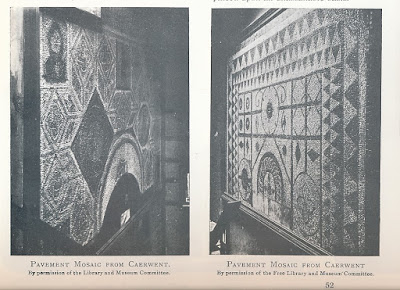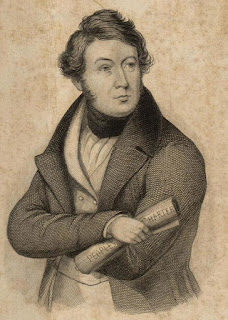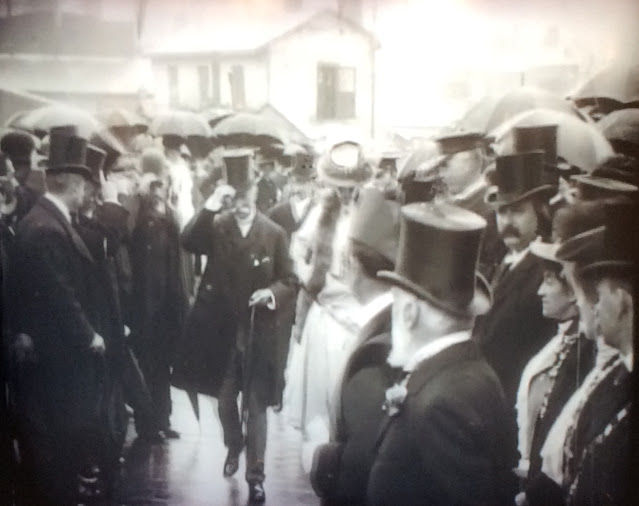What happened to the Roman mosaics in the old Dock Street Museum?
What happened to the Roman mosaics in the old
Dock Street Museum?
by Oliver Blackmore
Newport’s old Dock Street Museum displayed
two fine Roman mosaics from Caerwent. The black and white photograph below
shows them grandly flanking the museum stairway. The Dock Street Museum was
demolished in 1967. However, many Newportonians still remember the mosaics from
their childhood. One such person recently asked what had happened to the mosaics?
This presented the ideal opportunity to tell their story.
 |
The Caerwent mosaics displayed on the stairs
of the Dock Street Museum c. 1906.
|
Both mosaics date to the third century
AD – often called the ‘golden age of mosaics’ in Britain. Discovered in a Roman
house in Caerwent, the mosaics are from and associated with, a room called a ‘triclinium’.
A triclinium (named after the Greek ‘triklinion’) was a formal
oblong-shaped dining room, composed of three (‘tri’) couches (‘klinon’). Triclinia
were where middle and upper class Romans would eat, relax and entertain. Diners
would recline on the couches, whilst their slaves brought them various courses
of food.
The geometric mosaic was from the triclinium
itself. The figurative example, known as ‘the Four Seasons’ mosaic, is from an
adjoining room, connected and visible from the triclinium. The oblong shape of
the triclinium can be seen at the centre
point of the black and white photograph below, with the Four Seasons mosaic in
the foreground.
 |
Room 7 of House 7 (south) Caerwent, showing
the both the Triclinium and Four Seasons mosaics in situ. Photograph taken by
the CEF, c. 1901.
|
The mosaics were discovered in 1901 by
a group of archaeologists called the Caerwent Exploration Fund (CEF). They were
led by Thomas Ashby who went onto become the first director of the British
School in Rome. Ashby and his colleagues photographed the mosaics but were
unable to capture the vibrant colours (– colour photography was not widely available
until the 1930s). The CEF employed Frank King, a Bristol surveyor to complete
accurate watercolour drawings to record the polychrome mosaics in all their
splendour. Today, these watercolours form an important component of the CEF archive
at Newport Museum.
 |
Watercolour drawing of the Four
Seasons mosaic by Frank King, c. 1902
|
Particularly impressive, is the Four
Seasons mosaic, which diners would have looked across while reclining in the
triclinium. The female figures in the corners represent the seasons. The
cloaked figure in the top right is Winter; the bottom right is Spring; Summer is
at the bottom left and autumn is missing top left. The cupids in the medallions
hold torches, which relate to the seasons. The cupid near Spring is missing;
Summer has a cupid with a torch fully ablaze; Autumn, a fading flame and Winter
holds an extinguished torch. Mosaic experts have suggested Bacchus may have
been the missing central figure, being a fertility god and leader of the
seasons.
 |
Watercolour drawing of the Lower Pavement mosaic
of the triclinium by Frank King, c. 1902
|
The geometric mosaic associated with
the triclinium itself was excavated in two stages. Readers will notice that
Frank King’s drawing is annotated: ‘Lower Pavement’. This because there was a
later ‘Upper Pavement’, found on top of it. Roman tastes in interior design
changed overtime and the occupants of the house must have wanted to update the
mosaic in their triclinium. After all, it was the place they would formally
entertain guests. Unfortunately, the Upper Pavement was not in a good condition
and so the excavators took the decision to recover the earlier Lower Pavement, which
was better preserved. It along with the Four Seasons mosaic was set in concrete
sections and removed to Newport’s Dock Street Museum to be reassembled.
 |
The Lower Pavement reassembled on the ground
floor of John Frost Library, Museum and Art Gallery. © Patricia Witts, c. 1991.
When the Dock Street Museum was
demolished and the new John Frost Square Museum built, both mosaics were put
into storage with only fragments exhibited. It would not be until the 1980s,
that both mosaics would be displayed again. The Lower Pavement was displayed at
the bottom of the ground floor stairs (see photograph above). It remained there
until the 1990s, when it was again put into storage to make way for a fire
escape. The Four Seasons mosaic was painstakingly reconstructed in the late
1980s to form one of the star exhibits for the brand new Roman displays, which
opened in 1988 to celebrate Newport Museum and Art Gallery’s centenary. Thirty-two
years on, the Four Seasons mosaic still remains the focal point of the Newport
Museum’s Roman displays.
 |
The Four Seasons mosaic as currently displayed
in Newport Museum and Art Gallery


Comments
Post a Comment